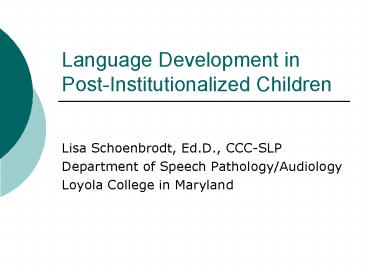Language Development in PostInstitutionalized Children - PowerPoint PPT Presentation
1 / 23
Title:
Language Development in PostInstitutionalized Children
Description:
The current study of children adopted from Eastern European orphanages ... child(ren) was receiving special education services at the time of the study. ... – PowerPoint PPT presentation
Number of Views:24
Avg rating:3.0/5.0
Title: Language Development in PostInstitutionalized Children
1
Language Development in Post-Institutionalized
Children
- Lisa Schoenbrodt, Ed.D., CCC-SLP
- Department of Speech Pathology/Audiology
- Loyola College in Maryland
2
Purpose
- The current study of children adopted from
Eastern European orphanages documented a three
year period of data collection on English
language acquisition as measured by a
standardized language assessment.
3
Review of pertinent literature
- The body of literature regarding language
development in the population of children adopted
from Eastern European countries is sparse, but
growing. - As of 2005, as many as 7,414 foreign visas were
granted for international adoption.
4
Effects of institutionalization on development
- Rutter evaluated children adopted from Romania
and found documented malnutrition, respiratory,
intestinal, and skin problems. - However, over a 2 year period, physical catch-up
was substantial, but developmental catch-up was
not complete.
5
Conditions in the orphanage
- Glennen (20022005) reported that poor health
care and nutrition, as well as overall lack of
stimulation is common. - Also common is fetal alcohol syndrome, infectious
and parasitic disease (Hepatitis B and C) and
tuberculosis.
6
Parent Report on Conditions
- Romanian orphanages by far are the worst.
- Parents report others to be better in terms of
overall stimulation, food, material items, and
ratio of children to adults.
7
Additional problems
- Reported problems in health records and
information given to parents at the time of
adoption. - Prenatal health information is questionable.
- Translation of medical terms into English is also
questionable.
8
Current studies
- The current studies on preschoolers in this
population by Glennen and Masters indicated that
infants and toddlers develop English in the same
growth patterns as non-adopted English speaking
peers. - The growth curve lags behind proportional to the
age at adoption.
9
Purpose of this study
- Glennen and Masters study indicated a need for
longitudinal research. - The authors also focused on younger children, not
those who were adopted at an older age. - The current study focused on the above variables.
10
Participants
- Forty eight children participated in the study
between 2000 and 2004. - Criteria for participation included
- 1. age between 3 and 16,
- 2. residence in the USA for at least one year,
- 3. adopted from and Eastern European orphanage,
11
Participants
- 4. ability to comprehend and speak English.
- Parents were asked to complete a detailed case
history and were recruited from the
Baltimore-Washington area.
12
Demographics
- Of the 28 females, and 20 males, the children
were primarily from Russia (24), Bulgaria (9),
Lithuania (2), Siberia (3), Ukraine (3), Romania
(4), and Kazakhstan (2). - All parents reported observing the orphanage from
which their child was adopted.
13
Educational/Health concerns
- Parents reported medical problems of rickets,
bowed leg, hernia, reactive attachment disorder,
ADHD, broken bones, brittle bones, asthma,
intestinal parasites, ear and sinus infections,
pneumonia, nerve damage, dyslexia, cleft lip and
palate and heart conditions.
14
Education concerns
- One third of the parents reported that they had
strong concerns of speech/language problems and
were pursuing services. - An additional third reported that their
child(ren) was receiving special education
services at the time of the study.
15
Instrumentation
- The CASL, an individually and orally administered
research-based, theory driven oral language
assessment battery for ages 3-21 was used. - The CASL evaluates four aspects of language.
- The Core Battery was administered to subjects
which represented aspects of each language
category.
16
Setting
- All testing was completed at the Loyola College
Clinical Centers. - Children were tested three times over a three
year period. - Testing times varied dependent upon when the
child entered the study.
17
Results and Discussion
- Findings from the ANOVA indicated that there was
little developmental change in language scores
across time, with the exception of non literal
language and pragmatic judgment. - Children averaged at or near the 50th percentile,
which is normal and average, and remained there
across time.
18
Results and Discussion
- What did change were the non-grammatical elements
of language. - Problems with pragmatics or the social use of
language may seem obvious. - The social rules of language can be best taught
through immersion in the culture and not just in
the classroom.
19
Findings
- In the current study, children demonstrated an
inappropriate response to a pragmatic cue. - This fact supports other literature suggesting
that there are pragmatic features that do not
transfer easily across cultures. - The result is that children may be put at risk
for academic and social failure without clinical
intervention.
20
Results and Discussion
- Other findings indicated a 5 gain in composite
scores between T1 and T3 which indicates average
growth across time. - This finding supports that of Glennen and Masters
that this population has relatively the same
growth pattern as non-adopted English speaking
peers.
21
Conclusion
- The results of the study overall support that
found by other researchers with the same but
younger population. - The findings that nonliteral language and
pragmatic language lags behind indicate the need
to carefully evaluate these children for services.
22
Recommendations
- Not all children need to be flagged as soon as
they enter the country. - However, educators need to monitor the child and
watch for areas that continue to lag behind and
make a referral sooner than later. - What ASHA states as necessary for identification
of LI in ELL learners.
23
Questions































